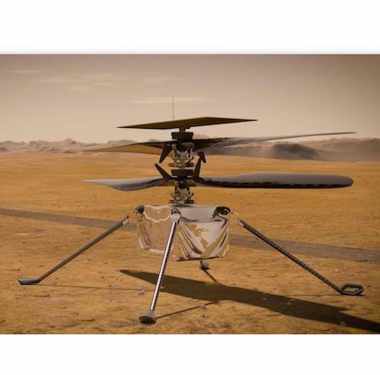| Linux-Powered Ingenuity Lands On Mars |
| Written by Lucy Black | |||
| Sunday, 21 February 2021 | |||
|
The latest Mars rover, Perseverance landed safely on the red planet this week, carrying with it Ingenuity a tiny drone helicopter hoping to be the first aircraft to fly on Mars. After a seven-month-long journey, NASA’s Perseverance Rover successfully touched down on the Red Planet on Feb. 18, 2021 to much jubilation at mission headquarters. Perseverance is described as a 1-ton mobile science laboratory. Its mission is to collect rock and soil samples and search for signs of ancient life in Jezero Crater, the site of a former lake. Ingenuity, by contrast weighs just 1.8kg, According to IEEE Spectrum: "Its body is the size of a box of tissues, slung underneath a pair of 1.2m carbon fiber rotors on top of four spindly legs." What Ingenuity has to do is demonstrate that flight on Mars is possible and given that Mars has a very thin atmosphere, only 1% of the density of Earth's atmosphere, having it take off and land will count as a great success. Ingenuity has a 30-day windows in which to operate. Three flights are pre-planned - and are all going to be takeoff, fly, and then come back and land in the same spot. Two further flights might be a bit more adventurous. This animation shows what is supposed to happen on these flights: Radiation is, of course, the big problem to be overcome in the exploration, and future exploitation, of Mars and the hardware for Perseverance itself was constrained by NASA's High-Performance Spaceflight Computing (HPSC) radiation standards. Because Ingenuity is only a technical demonstration it had greater freedom and, as Timothy Canham, the Mars Helicopter Operations Lead at NASA’s Jet Propulsion Laboratory explained in an interview with IEEE Spectrum, Ingenuity was built with off-the-shelf consumer hardware, saying: "In some cases we literally ordered parts from SparkFun [Electronics]. Our philosophy was, "this is commercial hardware, but we'll test it, and if it works well, we'll use it." So the drone uses a Qualcomm Snapdragon 801, a cellphone-grade IMU, a laser altimeter from SparkFun, and a downward-pointing VGA camera for monocular feature tracking. As far as the software is concerned, Canham told IEE Spectrum: This the first time we’ll be flying Linux on Mars. It isn't, however, the first time Linux will be used in an extra terrestrial context as its been used on the ISS since 2017. What is remarkable about Ingenuity is that Linux is the tip of the open source iceberg. The software framework it uses is F´, a framework developed at the Jet Propulsion Lab to enable the rapid development and deployment of spaceflight and other embedded software applications and open sourced a few years ago As Canham pointed out: It's kind of an open-source victory because we're flying an open-source operating system and an open-source flight software framework and flying commercial parts that you can buy off the shelf. More InformationHow NASA Designed a Helicopter That Could Fly Autonomously on Mars Related ArticlesMars Curiosity Rover Gets A Software Update Help Curiosity Avoid Sand On Mars To be informed about new articles on I Programmer, sign up for our weekly newsletter, subscribe to the RSS feed and follow us on Twitter, Facebook or Linkedin.
Comments
or email your comment to: comments@i-programmer.info |
|||
| Last Updated ( Sunday, 21 February 2021 ) |


